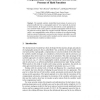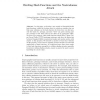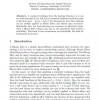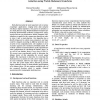AFRICACRYPT
2008
Springer
14 years 8 months ago
2008
Springer
Abstract. In the context of iterated hash functions, "dithering" designates the technique of adding an iteration-dependent input to the compression function in order to d...
CRYPTO
1991
Springer
14 years 10 months ago
1991
Springer
In this paper, we study the application of universal hashingto the construction of unconditionally secure authentication codes without secrecy. This idea is most useful when the nu...
GECCO
2006
Springer
14 years 10 months ago
2006
Springer
The design of hash functions by means of evolutionary computation is a relatively new and unexplored problem. In this work, we use Genetic Programming (GP) to evolve robust and fa...
FSTTCS
2006
Springer
14 years 10 months ago
2006
Springer
The standard symbolic, deducibility-based notions of secrecy are in general insufficient from a cryptographic point of view, especially in presence of hash functions. In this paper...
FSE
2006
Springer
14 years 10 months ago
2006
Springer
MD5 is a well-known and widely-used cryptographic hash function. It has received renewed attention from researchers subsequent to the recent announcement of collisions found by Wa...
FSE
2006
Springer
14 years 10 months ago
2006
Springer
The security of hash functions has recently become one of the hottest topics in the design and analysis of cryptographic primitives. Since almost all the hash functions used today ...
EUROCRYPT
2006
Springer
14 years 10 months ago
2006
Springer
In this paper, we develop a new attack on Damg
ESA
2006
Springer
14 years 10 months ago
2006
Springer
A standard technique from the hashing literature is to use two hash functions h1(x) and h2(x) to simulate additional hash functions of the form gi(x) = h1(x) + ih2(x). We demonstra...
EUROPAR
2004
Springer
14 years 10 months ago
2004
Springer
Abstract. Distributed protocols resilient to Byzantine failures are notorious to be costly from the computational and communication point of view. In this paper we discuss the role...
CIT
2006
Springer
14 years 10 months ago
2006
Springer
Hash functions play the most important role in various cryptologic applications, ranging from data integrity checking to digital signatures. Our goal is to introduce a new hash fu...




